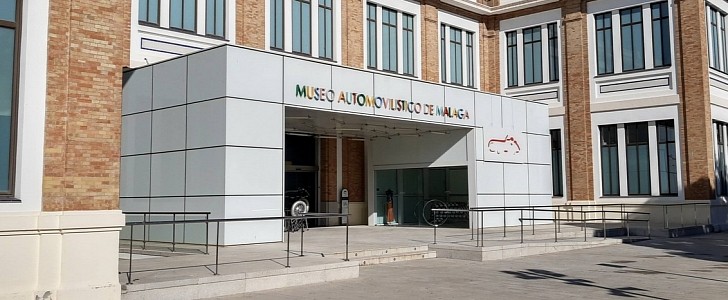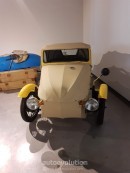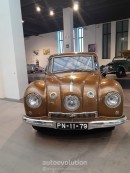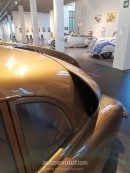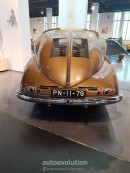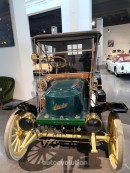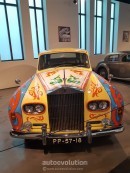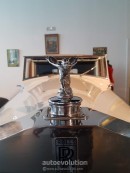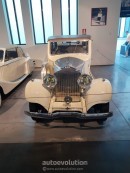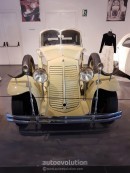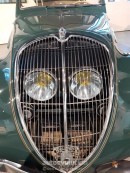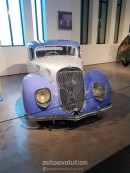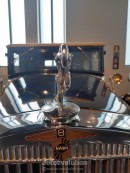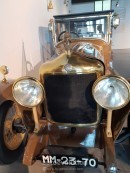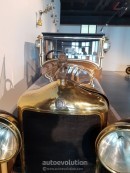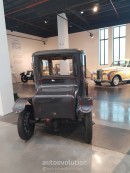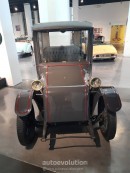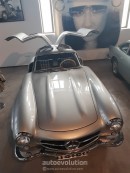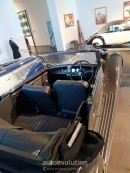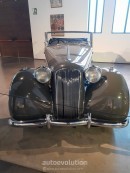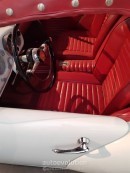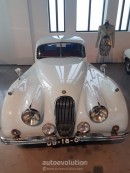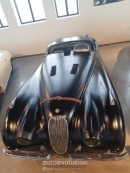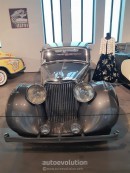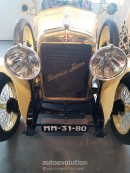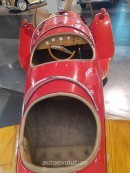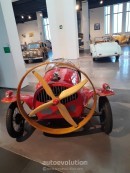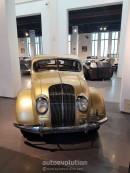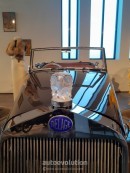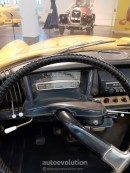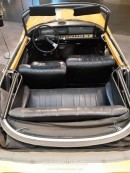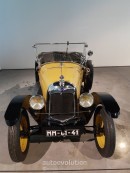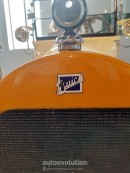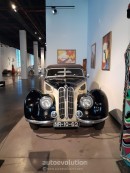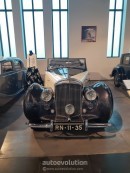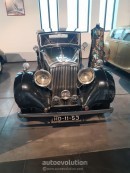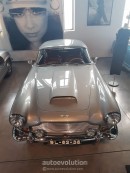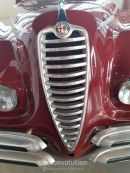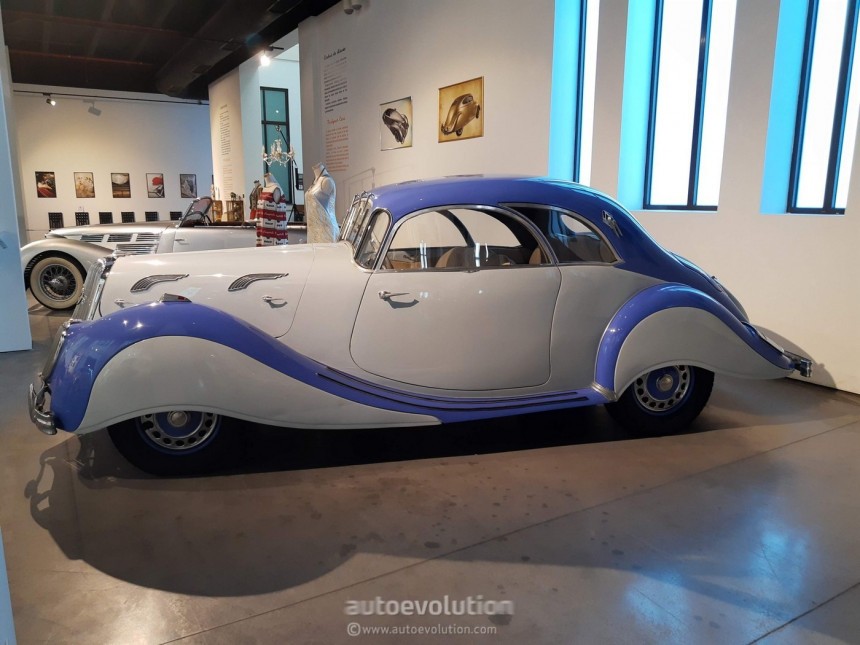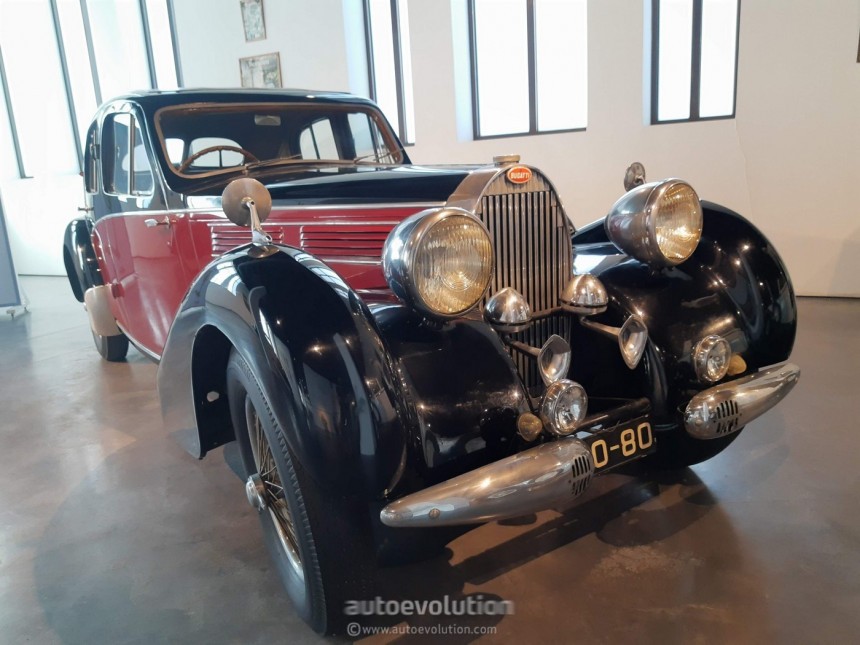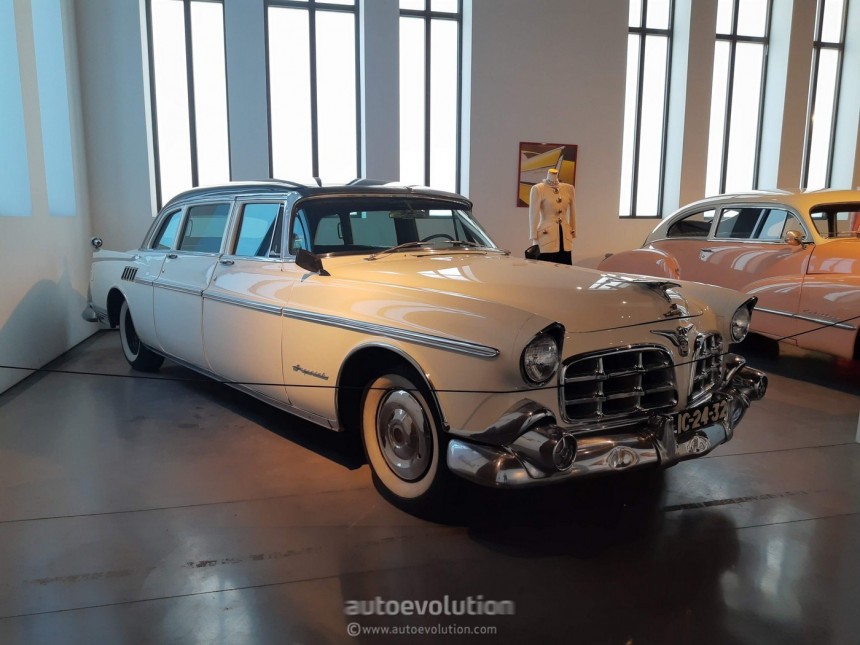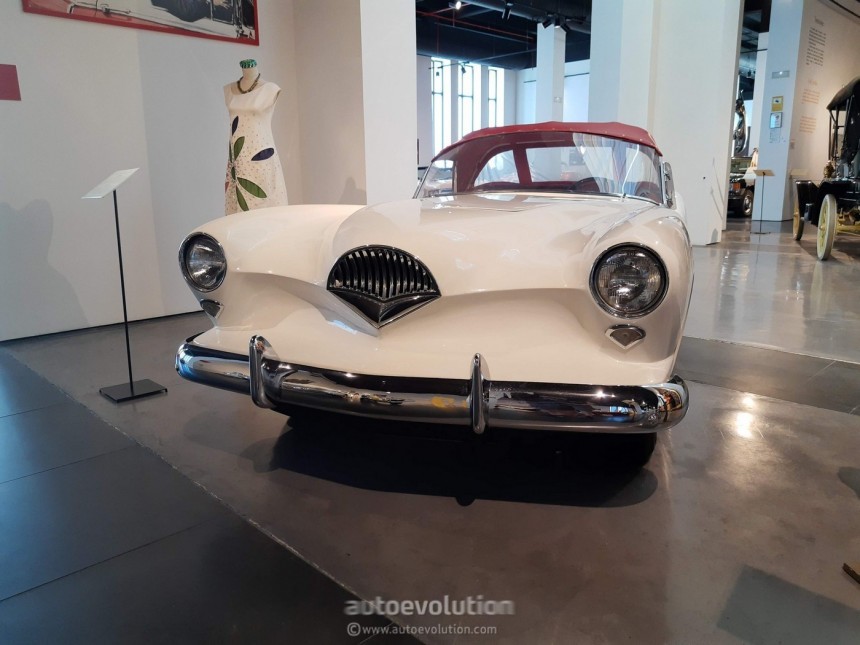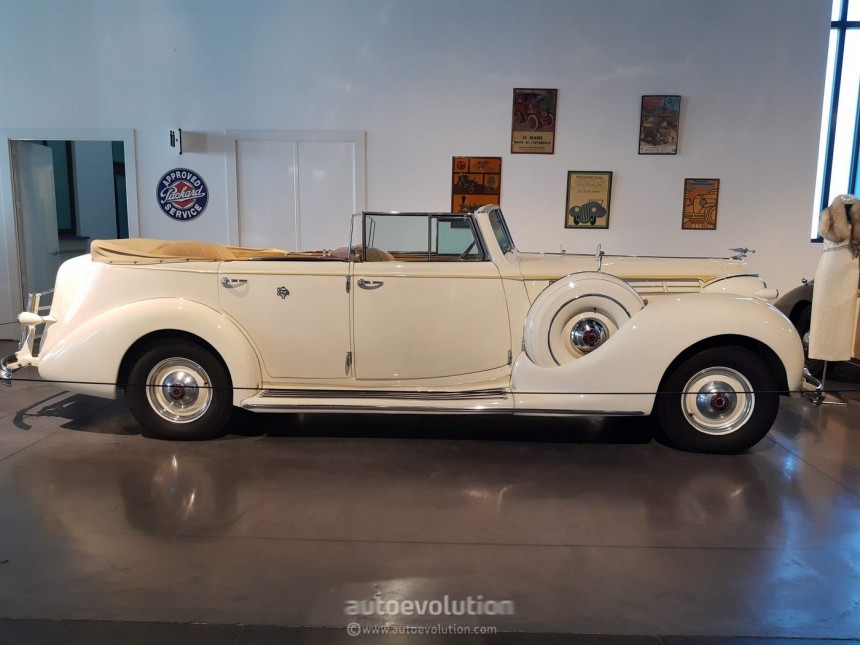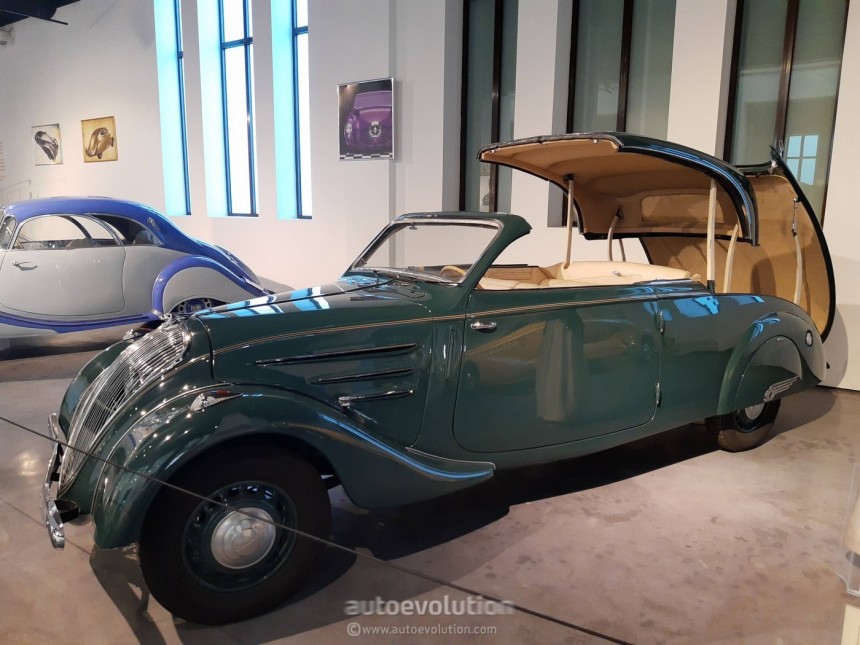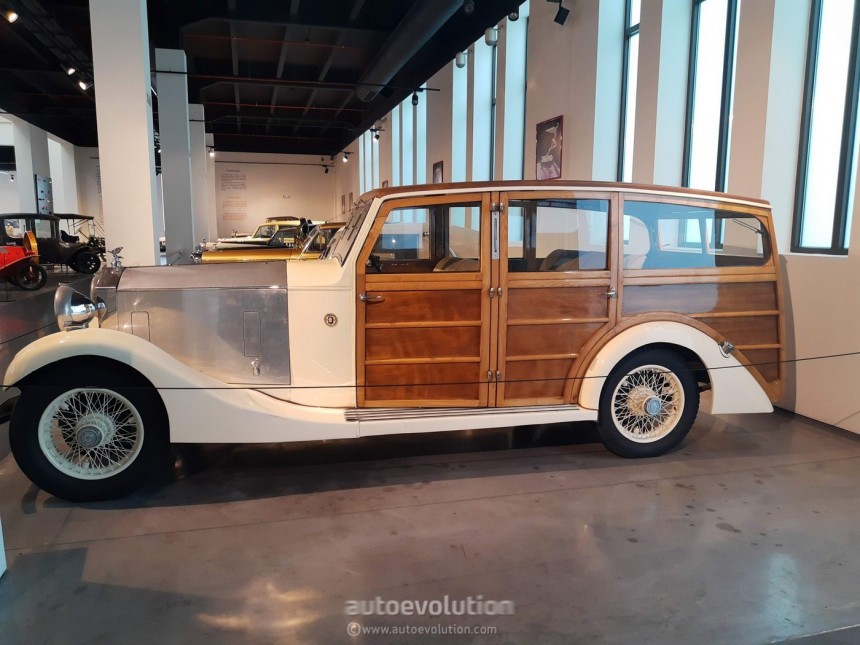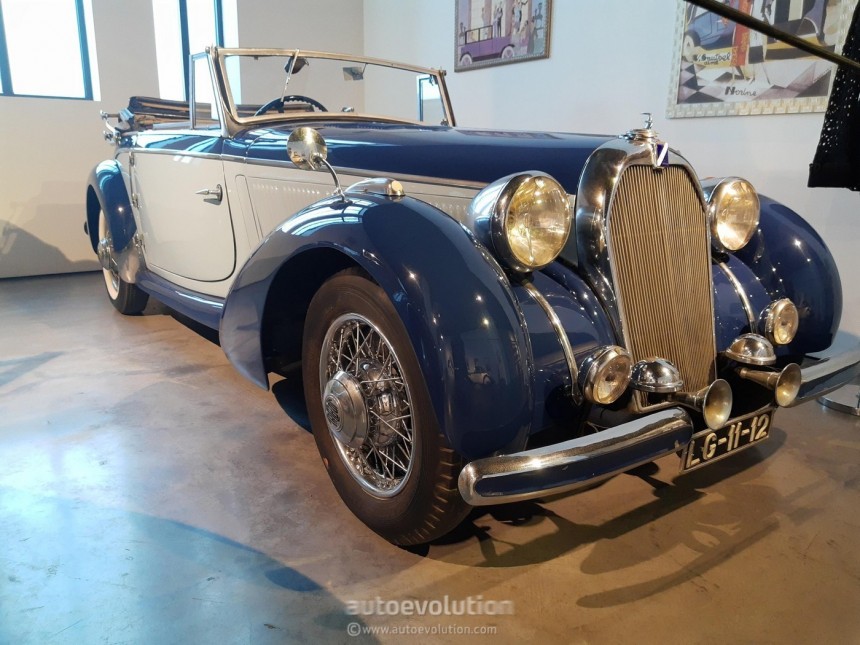Decades ago, Jose Antonio Magalhaes, a Portuguese fabric manufacturer, started to collect cars. He loved them, cared for them, and gathered them together into a small collection. Then, the Portuguese Revolution came at the beginning of the '70s, and some of its collection vanished.
Some of the cars were smuggled across the border in Spain and kept safe in a secret location. After things calmed down, he started to gain back what he lost, and even more. But life hit the car collection again, and the fabric manufacturer passed away.
His son, Joao Magalhaes, restarted the painful reconstruction of the car collection. He traveled around the world to find special cars that could fit in his collection, and then he added more vehicles. In the end, things straightened up, and all the cars found a place to be displayed: The Malaga Automobile Museum (Museo Automovilistico de Malaga).
Juao, as a fashion designer, didn't know anything about cars and mechanics. He just loved their shapes, inspired him, and made him bring only beautiful and rare vehicles. Some were found in barns, some were buried, and most of them were dismantled. The painful restoration process took a great deal of time, but as he said, "It was the impossible ones that took longer."
The museum is divided into a few sections: The Golden '20s, La Belle Epoque, Art Deco, Designer Cars, American dream cars, Alternative energies, English Tradition, La Dolce Vita, Tuning, and Engines. The big surprise for a car enthusiast is the fashion section, with hats, dresses, and accessories. While the cars might not be very appealing for ladies, the fashion area will.
Stepping inside the main entrance and it is like going through a gate to the past. It's like a time journey that will take you into the automobile industry's fascinating world, with plenty of unusual looking vehicles. You will find out the trial by errors the engineers made to get to the modern era, when a car is mainly just a method of transportation. Something you hop in, push a button, and you're ready to go.
From the steam-powered road-locomotives that needed at least 15 minutes to move a yard to electric cars from the early ages of the automotive industry, you'll find out that the vehicle you're driving today owns a history behind it. A history wrote with sweat and blood. After all, the engineers couldn't sit down, relax, and build a transportation device from A to B without any improvements.
As in many other areas, there was someone who tried to get there faster than everyone else. Then there was someone who wanted to get there in comfort. So, they asked for faster cars, for more comfortable vehicles, or some fancier-looking ones. The design met engineering and evolved together. From a carriage-like vehicle to the fast limousines from today, there were lots of trials and errors, and, sometimes, a mistake could even cost a life.
Just step inside the Malaga Automobile Museum, and you'll feel the smell of the past. The cars are parked one next to another, waiting to be admired again. The museum's owner didn't want to place the vehicles just sitting there and let you discover the technical data from each of them. No, each of them has a story. Like a Rolls-Royce that Magalhaes got it in exchange for a refrigerator. Another car is about a WWI pilot who only built a prototype, but he died before enjoying its creation.
Some cars deserve attention for their power, beauty, or luxury features in modern times. But there is something else with those old cars. Go near them and breathe. You'll feel their souls. Some are proud, some are modest, and some have stories to tell.
In the end, you can't go to Malaga just for the beaches, even if they are great. You can't stay all day long, sunbathing. Or, on a rainy day, you'll find some sun behind the gray weather just by walking in this museum. Best 10 euros ever spent on an automobile history lesson.
These are the museum's most imprtant assets, listed alphabetically:
Alfa Romeo 6C 2500 Sport - 1948
Alfa Romeo was a great racing brand, which produced beautiful cars and won many contests like the Villa d'Este and the Oporto in 1949. The model displayed was fed by a three carburetor engine made by Vittorio Jano.
Aston Martin DB2 – 1952
The DB2 prototype appeared at Le Mans in 1949, and sales started at the 1950 NY Auto Show. David Brown, Aston Martin's CEO, was convinced that it would be a great success and ensure an amazing future for the carmaker. His expectations were confirmed.
BMW 327 - 1939
It was the most charismatic BMW before WWII. It was a true Gran Turismo car of its era, with great performance and durability. Its sibling, the 328, dominated European races, winning Le Mans and the Mille Miglia in 1938 and 1940.
Bugatti 57 Galibier - 1939
Ettore started production at the Molsheim factory. The production of its artistic vehicles was limited, but its creations were ahead of their time. The Type 57 Galibier followed the same lines of the great Bugattis of the '30s. Later on, after Volkswagen Group relaunched the brand, Bugatti introduced a new model with the same name. The Veyron came after that.
Cord 1937 Model 812 Supercharged
It was a sports car built as a modernist piece of art made by Gordon Buehrig, the best car designer of its time. He revolutionized the market, introducing many innovations. Tyrone Power and Amelia Earhart were among his customers.
Ferrari 250 GT Speciale – 1956
Enzo Ferrari introduced the 250 GT in 1954 at the Paris Motor Show. It was built for wealthy customers who desired to travel fast. It was the first vehicle made by the Italian company that was not built to be raced.
Ford Thunderbird I – 1955
This car was the answer of the blue-oval brand from Detroit to its main rival, Chevrolet, who already introduced the Corvette. The 193 hp Thunderbird was a success, and among its customers was Arthur Miller, Marilyn Monroe's husband.
It was a luxury car made for Heads of State. There were only 175 units built. One of them belonged to Monaco's Principality, and in 1856 it was used to pick up Grace Kelly from the ship that brought her from New York. The same model was the official car of General Craveiro Lopez, the 12th President of Portugal. Imperial was Chrysler's luxury brand.
Jaguar E-Type Series I – 1961
Enzo Ferrari said about the E-Type that it is the most beautiful car ever made. The sports car was introduced in 1961 at the Geneva Motor Show. It was flawless for its era, with enough performance to keep up with the fastest road-legal vehicles and luxurious enough to compete with the best Gts on the market.
Jaguar XK120 Coupe - 1952
The XK120 was the fastest personal luxury coupe vehicle of its time. It was fast, luxurious, and expensive. It was chosen by high-class women such as Ingrid Bergman and Lauren Bacall. The 120 came from its official maximum speed: 120 mph (195 kph).
This was the only production coupe with a sliding door that hid behind the front fenders. It was more expensive than a Cadillac, slower than a Corvette, and not as agile as an M.G. T.F. or an Alfa Romeo. Kaiser sold only 435 cars despite its rust-proof bodywork, which was made out of fiberglass.
This presidential car was on top of its game in 1939. Similar models were used by King George VI of England and F. D. Roosevelt. There was a minibar in the back for a bottle of wine and a few glasses. The 7.8-liter V12 engine produced 175 hp.
If you think that the coupe-cabriolet started with the Peugeot 206 CC, you are wrong. It started with this Peugeot 402 Eclipse, which used an electric system to open or close the cabin's roof. This model was buried so the German Army wouldn't find it. It was one of the most difficult vehicles in the collection to restore.
Rolls-Royce produced the small Twenty between 1922 and 1929 as an alternative for the big, luxurious, Silver Ghost. While the carmaker tried to make this 20 hp model as a car for the owner, most of them were actually used with a driver. Antonio Magalhaes acquired it in exchange for a refrigerator.
Talbot-Lago T23 - 1938
Anthony Lago purchased the company in 1935 and brought many changes to the car before reviving it. Due to its 115 hp engine and the three seating position, this vehicle was a very desirable one. Marlene Dietrich inspired the color combination for the particular model displayed at Malaga Automobile Museum.
His son, Joao Magalhaes, restarted the painful reconstruction of the car collection. He traveled around the world to find special cars that could fit in his collection, and then he added more vehicles. In the end, things straightened up, and all the cars found a place to be displayed: The Malaga Automobile Museum (Museo Automovilistico de Malaga).
Juao, as a fashion designer, didn't know anything about cars and mechanics. He just loved their shapes, inspired him, and made him bring only beautiful and rare vehicles. Some were found in barns, some were buried, and most of them were dismantled. The painful restoration process took a great deal of time, but as he said, "It was the impossible ones that took longer."
The museum is divided into a few sections: The Golden '20s, La Belle Epoque, Art Deco, Designer Cars, American dream cars, Alternative energies, English Tradition, La Dolce Vita, Tuning, and Engines. The big surprise for a car enthusiast is the fashion section, with hats, dresses, and accessories. While the cars might not be very appealing for ladies, the fashion area will.
Stepping inside the main entrance and it is like going through a gate to the past. It's like a time journey that will take you into the automobile industry's fascinating world, with plenty of unusual looking vehicles. You will find out the trial by errors the engineers made to get to the modern era, when a car is mainly just a method of transportation. Something you hop in, push a button, and you're ready to go.
From the steam-powered road-locomotives that needed at least 15 minutes to move a yard to electric cars from the early ages of the automotive industry, you'll find out that the vehicle you're driving today owns a history behind it. A history wrote with sweat and blood. After all, the engineers couldn't sit down, relax, and build a transportation device from A to B without any improvements.
Just step inside the Malaga Automobile Museum, and you'll feel the smell of the past. The cars are parked one next to another, waiting to be admired again. The museum's owner didn't want to place the vehicles just sitting there and let you discover the technical data from each of them. No, each of them has a story. Like a Rolls-Royce that Magalhaes got it in exchange for a refrigerator. Another car is about a WWI pilot who only built a prototype, but he died before enjoying its creation.
Some cars deserve attention for their power, beauty, or luxury features in modern times. But there is something else with those old cars. Go near them and breathe. You'll feel their souls. Some are proud, some are modest, and some have stories to tell.
In the end, you can't go to Malaga just for the beaches, even if they are great. You can't stay all day long, sunbathing. Or, on a rainy day, you'll find some sun behind the gray weather just by walking in this museum. Best 10 euros ever spent on an automobile history lesson.
These are the museum's most imprtant assets, listed alphabetically:
Alfa Romeo 6C 2500 Sport - 1948
Alfa Romeo was a great racing brand, which produced beautiful cars and won many contests like the Villa d'Este and the Oporto in 1949. The model displayed was fed by a three carburetor engine made by Vittorio Jano.
Allard Model M – 1949
Sidney Allard was a clever engineer. One characteristic of his designs was the large American V8 engine placed in lightweight British sports cars, giving them a high power-to-weight ratio. The same recipe was used later on by Caroll Shelby when he built the AC Cobra 427.Aston Martin DB2 – 1952
The DB2 prototype appeared at Le Mans in 1949, and sales started at the 1950 NY Auto Show. David Brown, Aston Martin's CEO, was convinced that it would be a great success and ensure an amazing future for the carmaker. His expectations were confirmed.
Austin Model Seven B – 1930
Austin was the first British brand that built popular cars. The Seven was the first "baby-car," named after its low price. This model had a big contribution to the spreading of automobile use by the middle and lower classes. It was an answer to the increasing traffic and lack of space.Ballot 2LT – 1928
Ernest Ballot was a car manufacturer that only existed between 1921 and 1932. Hispano Suiza bought the company in 1931. The 2LT was equipped with the Baerth patent named the "convertible body." The windows were stored inside the doors when the car was completely open.Bentley 4 ¼ liter – 1936
Rolls-Royce acquired Bentley in 1933. They kept the usual lines of the brand and added quality and technical value to the cars. This model was prepared by Freeston&Webb, a prestigious coachbuilding company whose project was named "Top Hat" as a tribute to British humor.Bentley Mark VI – 1948
Impressive without being too flashy, the Mark VI was created when Europe was going through a deficiency of steel, and that led to a terrible shortage of new vehicles. Its presence was called for at the Ascot races, the meeting point for the London aristocracy.BMW 327 - 1939
It was the most charismatic BMW before WWII. It was a true Gran Turismo car of its era, with great performance and durability. Its sibling, the 328, dominated European races, winning Le Mans and the Mille Miglia in 1938 and 1940.
Bugatti 57 Galibier - 1939
Cadillac Model 62 II - 1947
The Cadillac was the luxurious car that received appreciation on both sides of the Atlantic. While its presence in the U.S. was increasing, in Europe, its main problem was the range. There were just too few gas stations to fill the tank, and the fuel consumption was huge.Cadillac Eldorado III – 1959
This is one of the most representative American cars in history. Everything on it was in excess: it was 5.7 meters (225 inches) long. It featured enormous rear fenders, a soft-top, chromed everything, and a landing strip-sized hood.Charron Model X – 1910
Charron was a French carmaker based in Paris, and it built cars until 1930. Its origins date back to 1901, when the company was founded. The car displayed in the Malaga Automobile Museum belonged to the aviation pioneer Santos-Dumont. It produced 22 hp, and it was like a sports car back in its era.Citroen Model C2 "5CV" - 1922
The 5CV was a car built for ladies, with harmonic proportions. It was a big success, with more than 80.000 units sold. It appeared at the same time as the Women's Liberation Movement. The 850 cc engine produced 11 hp.Cord 1937 Model 812 Supercharged
It was a sports car built as a modernist piece of art made by Gordon Buehrig, the best car designer of its time. He revolutionized the market, introducing many innovations. Tyrone Power and Amelia Earhart were among his customers.
Delage Model D6 3-Liter – 1949
The Delage was a work of art and beauty of its times, a car desired by the rich and famous. The interior was custom made for each buyer. The model displayed at the Malaga Museum featured ostrich leather and details in silver and ivory. The owner, Louis Delage, collaborated with Rene Lalique to create the gorgeous glass mascot named "The Eagle."Delage Model T – 1910
The French carmaker Delage built the Model T in 1910 with an additional, uncomfortable dickie seat, also known as the "mother-in-law" seat.Desoto Airflow 1934
Walter Chrysler founded the Desoto brand in 1928 and named it after the Spanish explorer Hernando De Soto. Like the Chrysler Airflow, the Desoto version shared most of its components with the much pricier Chrysler sibling. The unibody construction and the aerodynamic shape were too bold for its time, so the sales were too low.Ferrari 250 GT Speciale – 1956
Enzo Ferrari introduced the 250 GT in 1954 at the Paris Motor Show. It was built for wealthy customers who desired to travel fast. It was the first vehicle made by the Italian company that was not built to be raced.
Fiat 500 Topollino – 1936
The war was near, and the Italian carmaker built a car for the masses. It was cheap and aimed at the common people. Its nice, curved lines made the car successful in Italy and abroad as well. The U.K. customers were very happy with it.FN – Fabrique Nationale 1300 S – 1927
After Antonio Magalhaes sold the first F.N. during the Portuguese Revolution, his son tried to get it back later. It is uncertain if this is the same car or a sibling. It was found in Salt Lake City in the U.S. The 11 hp car made history for being the first vehicle to cross Africa from North to South.Ford Thunderbird I – 1955
This car was the answer of the blue-oval brand from Detroit to its main rival, Chevrolet, who already introduced the Corvette. The 193 hp Thunderbird was a success, and among its customers was Arthur Miller, Marilyn Monroe's husband.
Fuldamobil S1 – 1955
The little car was built by the Nordwestdeutscher Fahrzeugbau GmbH German company during the Great Rationalization period. Its design was made by Norbert Stevenson, a freelance journalist, in 1949. The S1 was the production version, and it featured a fiberglass bodywork. Due to its 200 cc engine, the driver didn't need to have a driving license.Helicron 2 – 1932
Marcel Leyat created this prototype after WWI. He used aviation parts and a four-stroke flat-four engine for it. There are only two vehicles of this kind left in the world. The other one is in the Lane Motor Museum in Nashville, Tennessee, in the U.S.Hispano Suiza Tipo 33 – 1923
The Spanish company built luxury and racing vehicles. It focused on the design and manufacturing of aviation engines, military vehicles, and weapons. It was established in Barcelona, and its products were at the same level as the top German or British carmakers.Hupmobile Hupp 20 – 1912
It was an expensive sports car for its time. It offered 20 hp, and only a few fortunate people could afford one. It was an eye catcher, that's why it was nicknamed the "Dandy Car."Il Pampero - 1914
In 1914, the British pilot Barron Ackroyd from the Royal Air Forces designed and produced the roadster called "Il Pampero." The car never got into production, and its designer lost its life in an air-combat against the famous Red-Barron squad, the "Flying Circus."Imperial Model C70 Crown Limousine – 1956
Jaguar E-Type Series I – 1961
Enzo Ferrari said about the E-Type that it is the most beautiful car ever made. The sports car was introduced in 1961 at the Geneva Motor Show. It was flawless for its era, with enough performance to keep up with the fastest road-legal vehicles and luxurious enough to compete with the best Gts on the market.
Jaguar MK IV – 1948
Jaguar built the MK IV for the conservative rich people of Britain. It was offered between 1945 and 1949. Its sober, gentle lines were convincing and it became very popular in the London's financial district.Jaguar M.K. V 3 ½ Drophead - 1948
This model was the Jaguar's flagship's new range and style of cars. It was unveiled at the 1948 London Motor show along with the XK120 sports car. This particular model was found in Alaska by Jose Magalhaes, the owner of the Malaga Automobil Museum.Jaguar XK120 - Roadster - 1954
While the M.K. V was built for luxury, the XK120 aimed for speed in both body versions. This particular roadster was a special order. But the regular vehicle was also very difficult to purchase unless you were a special customer such as Clark Gable or Humphrey Bogart.Jaguar XK120 Coupe - 1952
The XK120 was the fastest personal luxury coupe vehicle of its time. It was fast, luxurious, and expensive. It was chosen by high-class women such as Ingrid Bergman and Lauren Bacall. The 120 came from its official maximum speed: 120 mph (195 kph).
Kaiser Darrin - 1954
Lancia Astura - 1939
It was the last vehicle built by Lancia with a Pininfarina bodywork before the outbreak of WWII. An Italian Countess ordered it. The car featured a wooden dashboard and a boudoir with perfume bottles, including jars of makeup built into the back seats.Lancia Dilambda - 1934
It was Mussolini's parade car. This luxurious convertible vehicle was designed by Pininfarina and unveiled at the 1929 Paris Motor Show as an evolution of the already famous Lambda. Vincenzo Lancia improved its design over time. The model displayed at the Malaga Car Museum was used as a propaganda vehicle in the regime's parades.Lancia Kappa - 1921
Vincenzo Lancia started his career at Fiat, but in 1907 he founded his own company. The 1921 Kappa displayed at the Malaga Automobile Museum featured a distinctive piece of equipment: a telephone between the driver and the passenger compartment.Matford Alsace 66 – 1936
This custom vehicle was crafted by Rui So and the painter Paulo Rosa, and it is based on a 1936 Matford Alsace 66. Matford was the French arm of Ford after the Mathis carmaker went into financial troubles and was acquired by the American carmaker. The 90 hp Alsace 66 was built only for one year.Mercedes-Benz 540 K Kompressor – 1936
One of the most expensive cars before WWII was the Mercedes-Benz 540 Kompressor. It was presented at the 1936 Paris Motor Show, and it was a statement of technology and power. Its 180 hp supercharged engine allowed the massive vehicle to move fast on the new Autobahn, or the German highway network. Only 419 vehicles were built.Milburn Electric – 1916
Electric cars are not a thing of the XXIst Century, and this is a fine example. The American carmaker Milburn offered this efficient vehicle in 1916. It offered a range of 80 km (70 miles) and could run up to 25 kph (15 mph). Four thousand vehicles were built between 1915 and 1923 before General Motors acquired the company.Minerva Model 00 – 1923
The Belgian carmaker Minerva built its cars for the upper-class market. This model is a piece of evidence that the Belgians could build exclusive vehicles. Its Coupe de Ville bodywork was custom made, and its powerful, 30 hp engine was at the same levels as its competitors. The interior was decorated with silk and art nouveau lamps.Minerva Model A “Minervette” - 1906
The smallest vehicle built by the Belgian carmaker Minerva was introduced in 1904. The brand sold its products in U.K. through Charles Stewart Rolls, future co-founder of the famous Rolls-Royce company. The vehicle displayed was used by King Carlos I of Portugal during his trip to the town of Vidago. It was found in the same place six decades later.Morris Minor – 1931
Morris was one of the most important British brands. It covered 33% of the domestic markets. This model was one of the first to allow doctors to move quickly and not use donkeys as a means of transportation. Its 19 hp engine was more than enough, and its price was good for the middle class.Packard Model Twelve - 1939
Paige Jewett 6-54 Sedan – 1927
Joseph, Robert, and Ray Graham bought the Paige Detroit Motor Car Company and renamed it the Graham-Paige Company. They brought to life this art piece, which won many elegance contests like Prix d'Avant Gard at Lyon. A similar car to the one displayed at Malaga served in the Vatican.Panhard et Levassor Dynamic – 1938
The French carmaker built the Dynamic in a pure art deco style, and it featured a unibody welded construction. The steering wheel was placed where the customer asked to, and it was a luxurious vehicle. This particular model featured a center-mounted steering wheel.Peugeot 402 Eclipse – 1937
Pierce-Arrow Model 143 – 1930
George Pierce made a prestigious car in the USA. The American carmaker was noticed for building a special inline-six engine. It featured four side-valves and three spark-plugs per cylinder. It was a status car owned by many Hollywood stars and tycoons.Porsche 356 A Speedster – 1956
The Porsche brand wouldn't be a great carmaker today if the little, nimble, 356 car wouldn't have existed. This 1956 Roadster A was built in 1956. The version was ordered by Max Hoffman, Porsche's agent in the U.S., the same guy who persuaded Mercedes-Benz to produce the mighty 300 SL.Renault TG Nervastella – 1930
Renault was a luxury brand long before others could compete against it. This T.G. 4 was ordered as a hunting car by Mr. Astor, the New York Waldorf Astoria Hotel owner. Its design was inspired by the famous Spanish artist Salvador Dali.Renault CB – 1912
The Coupe de Ville version of the Renault CB provided a great foundation for the French carmaker. A similar model was embarked on the Titanic. A 12 hp engine powered it, and it was one of the most luxurious vehicles used by the French high-society.Rolls-Royce Model 20 HP Twenty – 1927
Rolls-Royce 25 hp Shooting Brake - 1932
Hunting was a tradition among the British aristocracy, and they asked for special bodyworks made on Rolls-Royce chassis to use as hunting vehicles. The wooden body made it look rustic and charming. It had a big success among the British colony's army in India, where they used it for hunting tigers.Rolls-Royce Phantom III – 1936
The Phantom III was the last Rolls-Royce fitted with a V12 engine until the 1998 Silver Seraph model. It was big and luxurious, and the all-aluminum engine offered 120 hp. It was the last car developed by Henry Royce.Stanley Steamer Model 70 – 1910
In 1900, steam-powered cars were still ahead of their internal combustion-engined competitors. They were the first to break the 100 kph (62 mph) record. But their reign didn't last long, especially after the electric starter for gasoline-powered vehicles was invented.Talbot-Lago T23 - 1938
